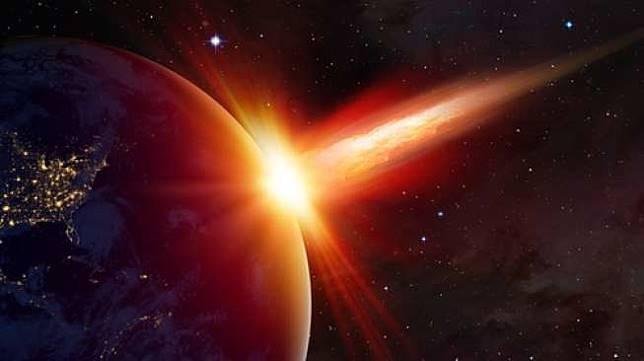
A recent study reveals that the Earth has experienced darkness for nearly two years, resulting in the extinction of about 75 percent of all species living on the surface of the planet.
The study, published in the journal Proceedings of the National Academy of Sciences on August 21, yesterday revealed that about 65.5 million years ago a giant asteroid hit the Earth and caused the sun to disappear from the sky for nearly two years.
This prolonged darkness is caused, one of them, by a cloud of ash coming from a vast fire on Earth. Without sunlight, plants on Earth can not photosynthesize and planets become very cold.
These two factors cause the destruction of the food chain on Earth and trigger one of the mass extinctions - when dinosaur species disappear - in Earth history.
The nearly 10km-long asteroid struck the area we now know as the Yucatan Peninsula, Mexico and is thought to have triggered earthquakes, tsunamis, and volcanic eruptions.
Rain of Fire
In addition, a collision between the asteroids and the Earth's surface also causes rocks to dissolve to evaporate into the atmosphere. In the atmosphere layer, the rocks re-solidify into small particles called spherules.
When these spherules return to rain on the Earth, they rub against each other, and ignite rain of fire throughout the Earth's surface. The remains of this spherule, according to scientists, can still be found today.
Most of the land animals of that time immediately died from asteroid blows, but "animals that live in the ocean or that can hide in soil or water, survived," says Charles Bardeen, a scientist from the National Center for Atmospheric Research (NCAR) in Boulder , Colorado, USA, who led the study.
"Our study sought to uncover the story after the collision - after an earthquake, tsunami, and extreme warming hit Earth," Bardeen explains.
"We want to examine the long-term consequences of the ash rains created after the impact and how those consequences affect the remaining living creatures," he further explained.
In this study Bradeen et al used the Community Earth System Model (CESM), a modern climate-chemical modeling that takes into account atmospheric, terrestrial, oceanic, and sea-ice related factors in its analysis.
With this modeling scientists can make simulations about the effects of ash clouds in the atmosphere on Earth in the yearly period after the fall of asteroids on Earth.
Ash Cloud
According to Bardeen several previous studies have shown that there are several types of particles, such as dust, sulfate, and ash or soot that sped into space after the asteroid hit Earth.
"All of these particles can block sunlight, but only a cloud of ash can heat the stratosphere and reduce sunlight on Earth's surface to a very low level," Bardeen said.
In the study, scientists also used the results of previous studies that estimate that the ash cloud or soot created by the fall of the asteroid weighs about 15,000 million tons.
"Our study shows that (with that much amount) ash can make the Earth dark enough so that plants can not photosynthesize for two years," added Bardeen.
Bardeen said this phenomenon has a terrible effect, especially for living things in the oceans that rely heavily on phytoplankton as the main food source.
"Losing this food source is a disaster for the entire food chain," he said.
Scrape Ozone
In addition to stopping photosynthesis, the ash clouds that envelop the Earth also block the sun's heat so it can not reach the Earth's surface.
About a year after the fall of the asteroid, the temperature on the mainland dropped by 28 degrees Celsius and the temperature in the ocean dropped to 11 degrees Celsius.
Conversely the temperature in the stratosphere heats up, because the ash clouds that float in the area absorb the sun's heat. This heat temperature is thought to have eroded the ozone layer and caused a large amount of water vapor to fill the stratosphere.
When this water vapor reacts chemically with the stratofer, it will create a hydrogen that further destroys the ozone layer.
As the ozone layer gets thinner and the ash cloud is thinning, the sun's ultraviolet rays - once filtered by ozone - hit the Earth and again ruin life on our planet.
As the stratosphere layer begins to cool, the water vapor there then turns to rain and sweeps ash clouds in the atmosphere.
As the ash clouds are depleted, the temperature in the stratosphere becomes colder so that the moisture vapors are turned into ice particles.
These ice particles in turn sweep more clouds of ash in the sky.
This process keeps repeating, so the ash cloud is finally gone from the atmosphere in a matter of months.
Study: Earth has been covered with Darkness for 2 Years
2 Comments
